|
|
|
| The application of aeromagnetic three-component upward continuation to recognizing physical parameters of geological body |
Xi-Zi LI1, Hua GUO1,2( ), Song HAN2, Hao-Jun LIU2, Qiang ZHENG1 ), Song HAN2, Hao-Jun LIU2, Qiang ZHENG1 |
1. College of Geophysics and Information Technique, China University of Geosciences, Beijing 100083, China
2. Aero Geophysical Survey and Remote Sensing Center for Natural Resources, Beijing 100083, China |
|
|
|
|
Abstract China developed the aeromagnetic three-component measurement system in 2017; nevertheless, the application of the three-component data is still in the exploratory stage. At first, the authors derived the upward continuation formula of magnetic three-component data and obtained the formula for the first time. Then the authors designed cube combinational models, with depth of center point ,volume, magnetization in different depths and depth of top surface as the variables. The relationship between minimum continuation height and physical parameters was obtained. In addition, the authors summarized some laws from these models. Finally, these conclusions were combined with the actual aeromagnetic three-component data. According to the geological condition of the survey area, the interpretation was made and good results were obtained.
|
|
Received: 29 October 2018
Published: 15 August 2019
|
|
|
|
Corresponding Authors:
Hua GUO
E-mail: hyguohua@126.com
|
|
|
|

|
Plan of the first group model
a— the position of the A group model on X-Y plane; b— the position of the A group model on X-Z plane; c— the position of the B group model on X-Y plane; d— the position of the B group model on X-Y plane
|

|
Contour map of the first group model
a— the contour map of A group model's north-component before continuation; b— the contour map of A group model's north-component after continuation 472 m; c— the contour map of A group model's north-component after continuation 3 540 m; d— the contour map of B group model's north-component before continuation; e— the contour map of B group model's north-component after continuation 826 m; f— the contour map of B group model's north-component after continuation 3 894 m
|

|
Profile anomalies of the first group model
a— the graph of north-component of A group's profile along X direction; b— the graph of north-component of A group's profile along X direction after continuation 472 m; c— the graph of A group model's after filtering out deep abnormal body; d— the graph of north-component of B group's profile along Y direction; e— the graph of north-component of B group's profile along Y direction after continuation 826 m; f— the graph of B group model's after filtering out deep abnormal body
|

| 参数 | A组1号 | A组2号 | B组1号 | B组2号 | | 立方体中心点位置/m | (2500,2000) | (1500,2000) | (2000,1500) | (2000,2500) | | 中心埋深/m | 500 | 1000 | 200、250、300、350、400 | 500、600、700、800、900 | | 磁化强度/(A/m) | 1 | 1 | 1 | 1 | | 测点间距/m | 118 | 118 | 118 | 118 |
|
The geometric and physical parameters of the first group model
|

|
Continuation value of the first group model
a—the line chart of continuation height of filtering out A group's deep body;b—the line chart of continuation height of filtering out B group's deep body
|

|
Plan of the second group model
a—the position of the A group model on X-Y plane; b—the position of the A group model on X-Z plane; c—the position of the B group model on X-Y plane; d—the position of the B group model on X-Z plane
|

|
Contour map of the second group model
a—the contour map of A group model's north-component before continuation;b—the contour map of A group model's north-component after continuation 708 m;c—the contour map of A group model's north-component after continuation 4 956 m;d—the contour map of B group model's north-component before continuation;e—the contour map of B group model's north-component after continuation 590 m;f—the contour map of B group model's north-component after continuation 826 m;g—the contour map of B group model's north-component after continuation 4 248 m
|

|
Profile anomalies of the second group model
a—the graph of north-component of A group's profile along X direction;b—the graph of north-component of A group's profile along X direction after continuation 702 m;c—the graph of A group model's after filtering out deep abnormal body;d—the graph of north-component of B group's profile along Y direction;e—the graph of north-component of B group's profile along Y direction after continuation 590 m;f—the graph of north-component of B group's profile along Y direction after continuation 826 m;g—the graph of B group model's after filtering out deep abnormal body
|

| 参数 | A组1号 | A组2号 | B组1号 | B组2号 | B组3号 | | 立方体中心点位置 | (2500,2000) | (1500,2000) | (2000, 800) | (2000,1600) | (2000,2600) | | 体积 | 100万m3 | 800万m3 | 12.5万m3 | 100万m3 | 800万m3 | | 磁化强度 | 1 A/m | 1 A/m | | 测点间距 | 118 m | 118 m |
|
The geometric and physical parameters of the second group model.
|

|
Continuation value of the second group model
a—the line chart of continuation height and A group model's depth of deep model;b—the line chart of continuation height and B group model's depth of deep model
|

|
The plane of the third group of model
|

|
Contour map of the third group model
a—the contour map of A group model's north-component before continuation;b—the contour map of A group model's north-component after continuation 472 m;c—the contour map of A group model's north-component after continuation 3 540 m;d—the contour map of B group model's north-component before continuation;e—the contour map of B group model's north-component after continuation 826 m;f—the contour map of B group model's north-component after continuation 3 540 m
|

|
Profile anomalies of the third group model
a—the graph of north-component of A group's profile along Y direction;b—the graph of north-component of A group's profile along Y direction after continuation 472 m;c—the graph of A group model's after filtering out deep abnormal body;d—the graph of north-component of B group's profile along Y direction;e—the graph of north-component of B group's profile along Y direction after continuation 826 m;f—the graph of B group model's after filtering out deep abnormal body
|

| 参数 | A组1号 | A组2号 | B组1号 | B组2号 | | 立方体中心点位置/m | (2000, 1500) | (2000,2500) | (2000, 1500) | (2000,2500) | | 磁化强度/(A·m-1) | 1 | 2增加到8 | 2增加到10 | 1 | | 模型中心点埋深/m | 500 | 1000 | 500 | 1000 | | 测点间距/m | 118 | 118 |
|
The geometric and physical parameters of the third group model
|

|
Continuation value of the third group model
a—the line chart of continuation height and magnetization of A group's deep model;b—the line chart of continuation height and magnetization of B group's shallow model
|
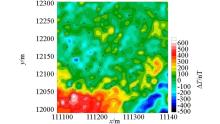
|
The contour map of the north-component
|
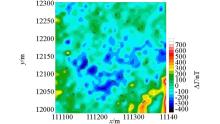
|
The contour map of the east-component
|
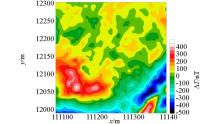
|
The contour map of the vertical-component
|
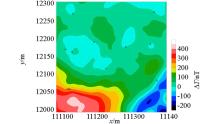
|
The contour map of the north-component after 12 meters continuation
|
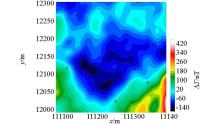
|
The contour map of the east-component after 12 meters continuation
|
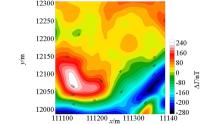
|
The contour map of the vertical-component after 12 meters continuation
|
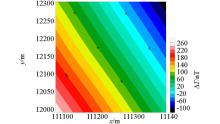
|
The contour map of the north-component after 210 meters continuation
|
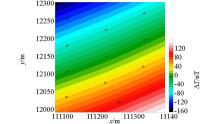
|
The contour map of the east-component after 220 meters continuation
|
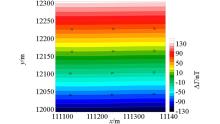
|
The contour map of the vertical-component after 250 meters continuation
|
| [1] |
闫辉, 肖昌汉, 张朝阳 , 等. 三分量磁场延拓的递推算法[J]. 计算物理, 2010,27(5):705-710.
|
| [1] |
Yan H, Xiao C H, Zhang C Y , et al. Recursive algorithm for three-component magnetic field continuation[J]. Computational Physics, 2010,27(5):705-710.
|
| [2] |
赵俊峰 . 南海北部海盆三分量磁测结果分析[J]. 热带海洋学报, 2009,28(4):54-58.
|
| [2] |
Zhao J F . Analysis of three-component magnetic survey result in the northern south China sea basin[J]. Journal of Tropical Oceanography, 2009,28(4):54-58.
|
| [3] |
赵俊峰 . 海洋三分量磁测资料处理及方法研究[C]// 中国地球物理学会第十五届年会论文集, 1999.
|
| [3] |
Zhao J F . Research on processing and method of marine three-component magnetometric data[C]// Papers of the 15th Annual Conference of the CGS, 1999.
|
| [4] |
西永在, 王传雷, 刘江平 , 等. 地面三分量磁测的观测误差分析. 工程地球物理学报, 2009,6(6):703-707.
|
| [4] |
Xi Y Z, Wang C L, Liu P J , et al. Observation error analysis of three-component magnetometry on the ground. Chinese Jounal of Engineering Geophysics, 2009,6(6):703-707.
|
| [5] |
孙昂, 郭华, 田明阳 , 等. 基于欧拉反褶积方法的航磁三分量应用研究[J]. 地球物理学报, 2017,60(11):4491-4505.
|
| [5] |
Sun A, Guo H, Tian M Y , et al. Research on aeromagnetic three-component application based on Euler deconvolution method[J]. Chinese Jounal of Geophysics, 2017,60(11):4491-4505.
|
| [6] |
曾华霖, 许德树 . 最佳向上延拓高度的估计[J]. 地学前缘, 2002,9(2):499-504.
|
| [6] |
Zeng H L, Xu D S . Estimation of the best upward extension height[J]. Geoscience Frontiers, 2002,9(2):499-504.
|
| [7] |
孟慧 . 磁梯度张量正演、延拓、数据解释方法研究[D]. 长春:吉林大学, 2012: 23-25.
|
| [7] |
Meng H . Research on forward, continuation and data interpretation methods of magnetic gradient tensor[D]. Chang Chun:Jilin University, 2012: 23-25.
|
| [8] |
许仪西, 何万平, 徐立 , 等. 福建地区岩石圈磁异场的特征分析[J]. 地震工程学报, 2017,39(6):1084-1089.
|
| [8] |
Xu Y X, He W P, Xu L , et al. Characteristics of magnetic anomalies in the lithosphere of Fuijian area[J]. Journal of Seismic Engineering, 2017,39(6):1084-1089.
|
| [9] |
刘鹏飞, 刘天佑, 朱培民 , 等. 吉林板石沟铁矿磁异常的精细解释[J]. 物探与化探, 2016,40(2):290-295.
|
| [9] |
Liu P F, Liu T Y, Zhu P M , et al. Fine Interpretation of magnetic anomalies in banshigou iron mine, Jilin Province[J]. Geophysical and Geochemical Exploration, 2016,40(2):290-295.
|
| [10] |
孙海龙, 许石 . 解析延拓法在识别磁异常中的应用[C]// 中国地球物理学会会议论文集, 2016: 78.
|
| [10] |
Sun H L, Xu S . Application of analytical extension method in recognition of magnetic anomalies[C]// . Proceedings of the Conference of the Chinese Geophysical Society, 2016: 78.
|
| [11] |
王景然, 张启国, 顾建松 , 等. 磁法延拓在地磁背景场匹配中的应用研究[J]. 海洋测绘, 2015,35(3):36-38.
|
| [11] |
Wang J R, Zhang Q G, Gu J S , et al. Application of Magnetic Method Extension in Matching Geomagnetic Background Field[J]. Marine surveying and mapping, 2015,35(3):36-38.
|
| [12] |
王英超, 王晓辉, 王明明 , 等. 地球物理方法在智利第一大区南部X矿区的应用[J]. 物探与化探, 2014,38(5):901-909.
|
| [12] |
Wang Y C, Wang X H, Wang M M , et al. Application of geophysical method to X mining area in the south of Chile's first region[J]. Geophysical and Geochemical Exploration, 2014,38(5):901-909.
|
| [13] |
柳建新, 李庆华 . 地面高精度磁法在塞拉利昂洛琴铁矿区的应用[J]. 物探与化探, 2014,38(4):649-653.
|
| [13] |
Liu J X, Li Q H . Application of ground high precision magnetic method in Luoqin iron mine, Sierra Leone[J]. Geophysical and Geochemical Exploration, 2014,38(4):649-653.
|
| [14] |
闫磊, 李明, 潘文庆 , 等. 塔里木盆地二叠纪火成岩分布特征——基于高精度航磁资料[J]. 地球物理学进展, 2014,29(4):1843-1848.
|
| [14] |
Yan L, Li M, Pan W Q , et al. Distribution characteristics of permian igneous rocks in Tarim basin based on high precision aeromagnetic data[J]. Progress in Geophysics, 2014,29(4):1843-1848.
|
| [15] |
孙海龙, 吕伟星, 陈鑫 , 等. 解析延拓法在山阳磁法数据解释中的应用[J]. 中国煤炭地质, 2017,29(2):78-82.
|
| [15] |
Sun H L, Lv W X, Chen X , et al. Application of analytical extension method in data interpretation of Shanyang magnetism method[J]. Coal Geology of China, 2017,29(2):78-82.
|
| [16] |
邱耀东, 聂琳娟, 张兵兵 . 局部重力异常向上延拓的实用算法[J]. 测绘科学, 2017,42(4):39-42,60.
|
| [16] |
Qiu Y D, Nie L J, Zhang B B . Practical algorithm for upward continuation of local gravity anomalies[J]. Science of Surveying and Mapping, 2017,42(4):39-42,60.
|
| [17] |
郭华, 王平, 朱春华 , 等. 向上延拓对航磁梯度数据的影响及其规律研究[J]. 地球物理学进展, 2015,30(3):1214-1223.
|
| [17] |
Guo H, Wang P, Zhu C H , et al. Study on the influence of upward continuation on aeromagnetic gradient data and its regularity[J]. Progress in Geophysics, 2015,30(3):1214-1223.
|
| [18] |
管志宁 . 地磁场与磁力勘探[M]. 北京: 地质出版社, 2005: 166-167.
|
| [18] |
Guan Z N. Geomagnetic field and magnetic exploration[M]. Beijing: Geological Publishing House, 2005: 166-167.
|
| [19] |
刘冬节 . 不同产状磁性体的磁异常特征[J]. 中国煤炭地质, 2010,22(2):59-63.
|
| [19] |
Liu D J . Magnetic anomaly characteristics of magnets with different occurrences[J]. Coal Geology of China, 2010,22(2):59-63.
|
| [20] |
佘宏全, 李进文, 向安平 , 等. 大兴安岭中北段原岩锆石U-Pb测年及其与区域构造演化关系[J]. 岩石学报, 2012,28(2):571-594.
|
| [20] |
She H Q, Li J W, Xiang A P , et al. U-Pb ages of the zircons from primary rocks in middle-northern Daxinganling and its implications to geotectonic evolution[J]. Journal of Petrology, 2012,28(2):571-594
|
|
|
|

